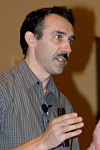Director's Corner
21 September 2006
 Barry Barish |
The Evolving ILC Design: Changing the Crossing Angles
Optimising cost to performance for the ILC design is a challenging task. Our working groups have identified a number of possible design changes, motivated by large potential cost savings. Changing the crossing angles for the final focus interaction regions is one item that has been under discussion for some time now. Last fall, we adopted an ILC baseline that had two beam lines -- one with a crossing angle of 2mrad and the other with 20mrad. The design of the resulting beam delivery system staggered interaction points in two separate detector halls. Motivated by the significant cost savings, as well as lower risk, we recently decided to change the beam line configuration to having two beam lines with 14mrad crossing angles. It is a particularly notable change, because of the potential physics impacts, which had to be weighed against the cost savings and lower risk.
Interestingly, the original motivation for the 2mrad x 20mrad configuration was partially based on the perceived complementary physics capabilities of having different crossing angles, as well as different technical risks. The physics mode that is most affected by the crossing angle is the slepton (supersymmetric partner of the lepton) pair production, in which the slepton-LSP (lightest supersymmetric particle) mass difference is small -- the so-called co-annihilation region. Here the main background is from 2-photon processes, and an efficient low-angle electron tag is needed to veto them, which is easier at small crossing angles. Data from the Large Hadron Collider may indicate whether such scenarios are relevant well in advance of ILC construction and that could, in principle, motivate a reconsideration of small crossing angles. That decision, however, would need to be weighed against the likely increased integrated luminosity resulting from simpler machine operations for the large crossing angle.
Rather than having staggered interaction points and separate halls, one new feature of the crossing angle change is a single experimental hall that contains both interaction regions. There are some obvious advantages, but there are also questions as to whether activity on one detector will interfere with the other and whether there will be safety issues. These points will require further study. It is also believed that possible future gamma-gamma options, meaning that we create high energy gamma rays near the end of each accelerator and collide them with each other, will not be excluded by this change.
This is the first change request since reliable cost information has been available. Therefore, it marks the first time we have been able to make decisions based on weighing all the factors: cost, risk and science performance. In order to assess the scientific impacts of the change, the Change Control Board formally asked the World Wide Study for input. In turn, the WWS solicited inputs from the physics community and submitted a written report. They supported the change but under the provision that R&D for small-angle crossing continues, allowing for a reconsideration of the small angle option at a later date.
Although this action is now completed, it may well not be the end of the story. This change prompts consideration of further optimisation of the design for 14mrad crossings, including a reconsideration of the muon shielding problem, how to preserve the upgrade option to 1 TeV with minimal up-front investment, and finally whether employing a single beam line and interaction region is a viable option to consider.
Using the same interaction point to service two complementary detectors, this push-pull system (meaning the two detectors alternately move on and off the beam line) would eliminate an entire expensive beam line. We plan to form a special group of experimentalists, accelerator physicists and engineers to do a careful study before our next GDE meeting in Valencia, where we will schedule an informed discussion of this option with the ILC community.
The whole process of developing and considering this change was done very carefully and professionally, and it portends well for other changes we are contemplating. I applaud all of those involved.
-- Barry Barish
